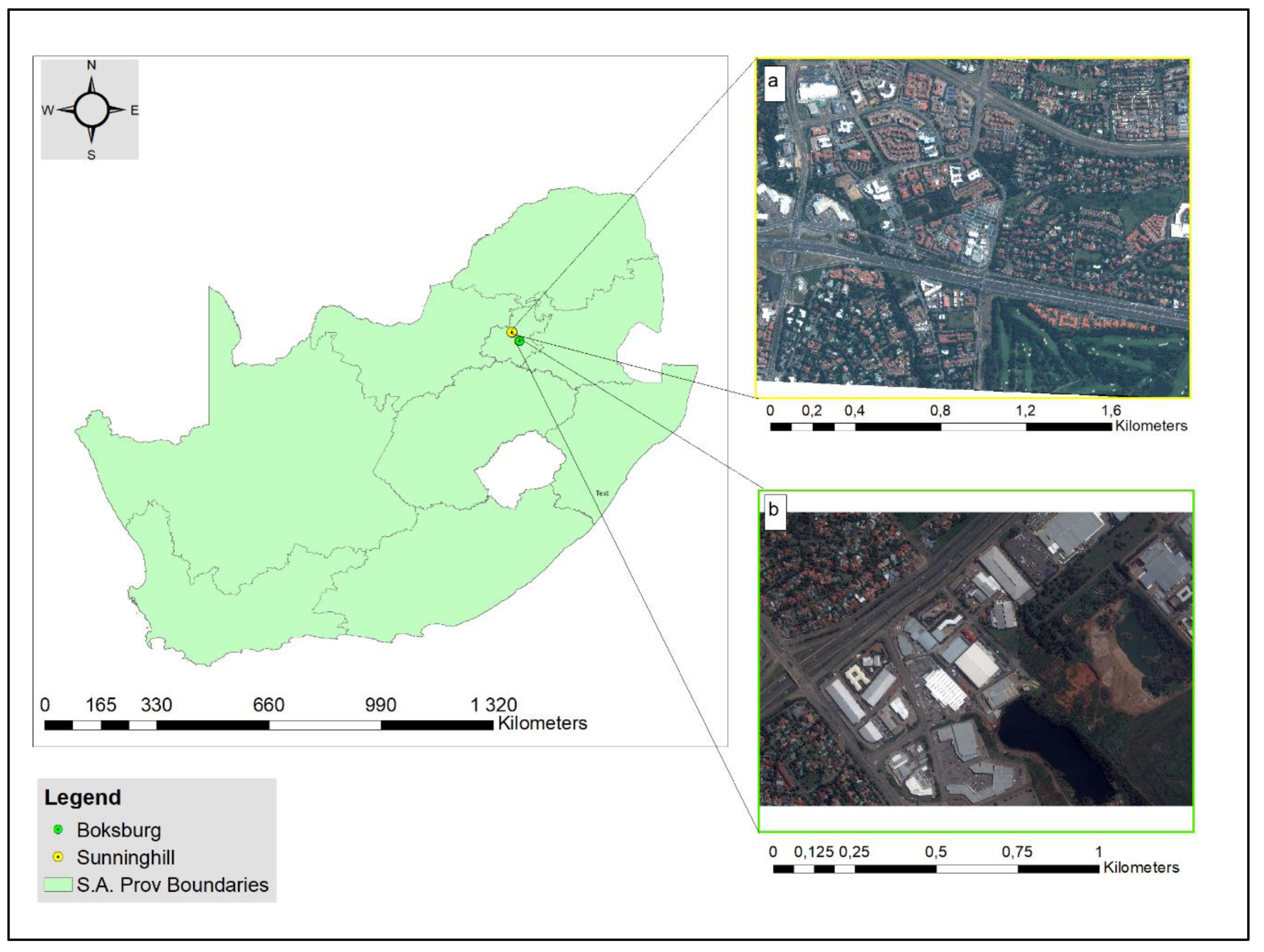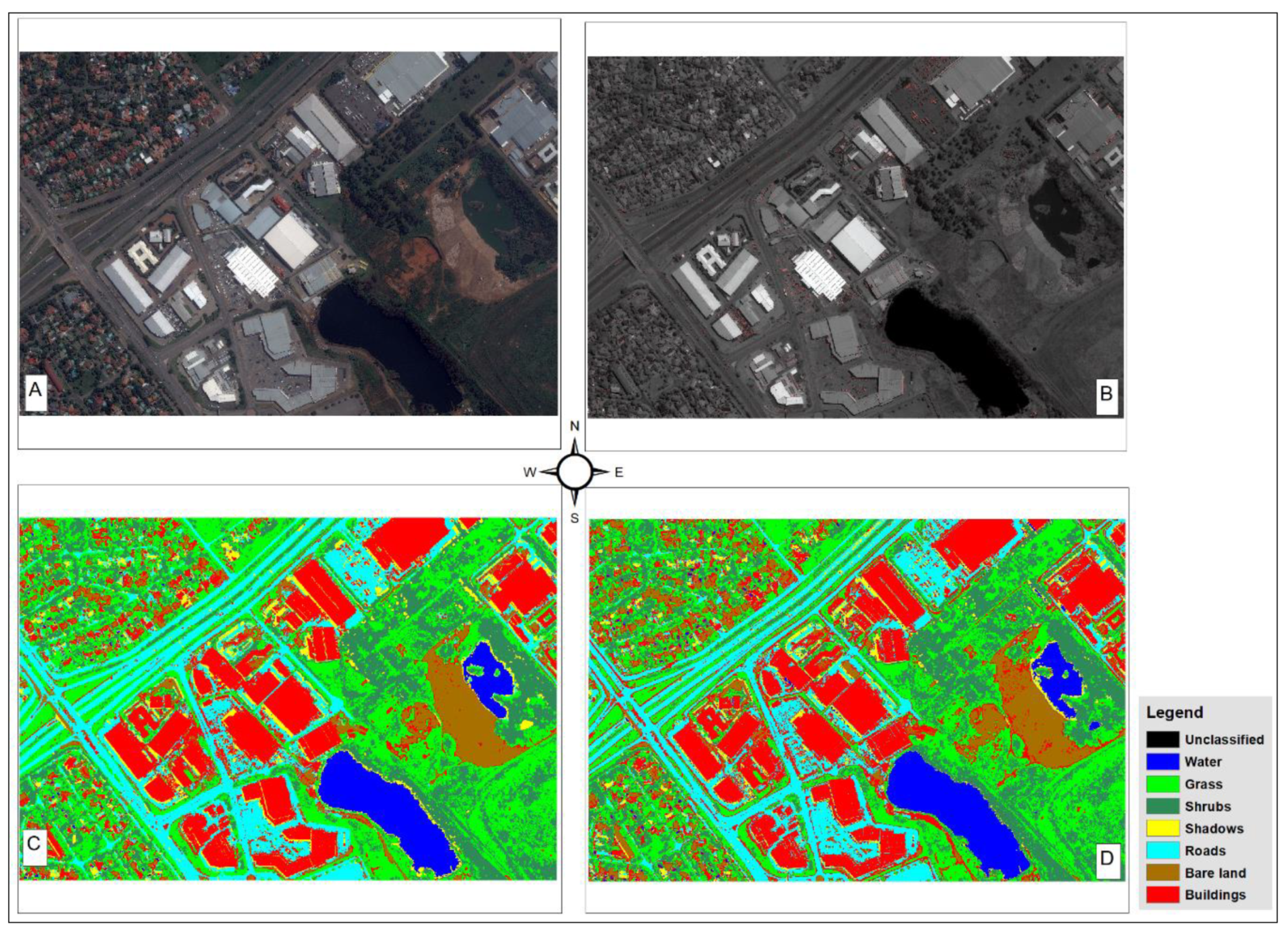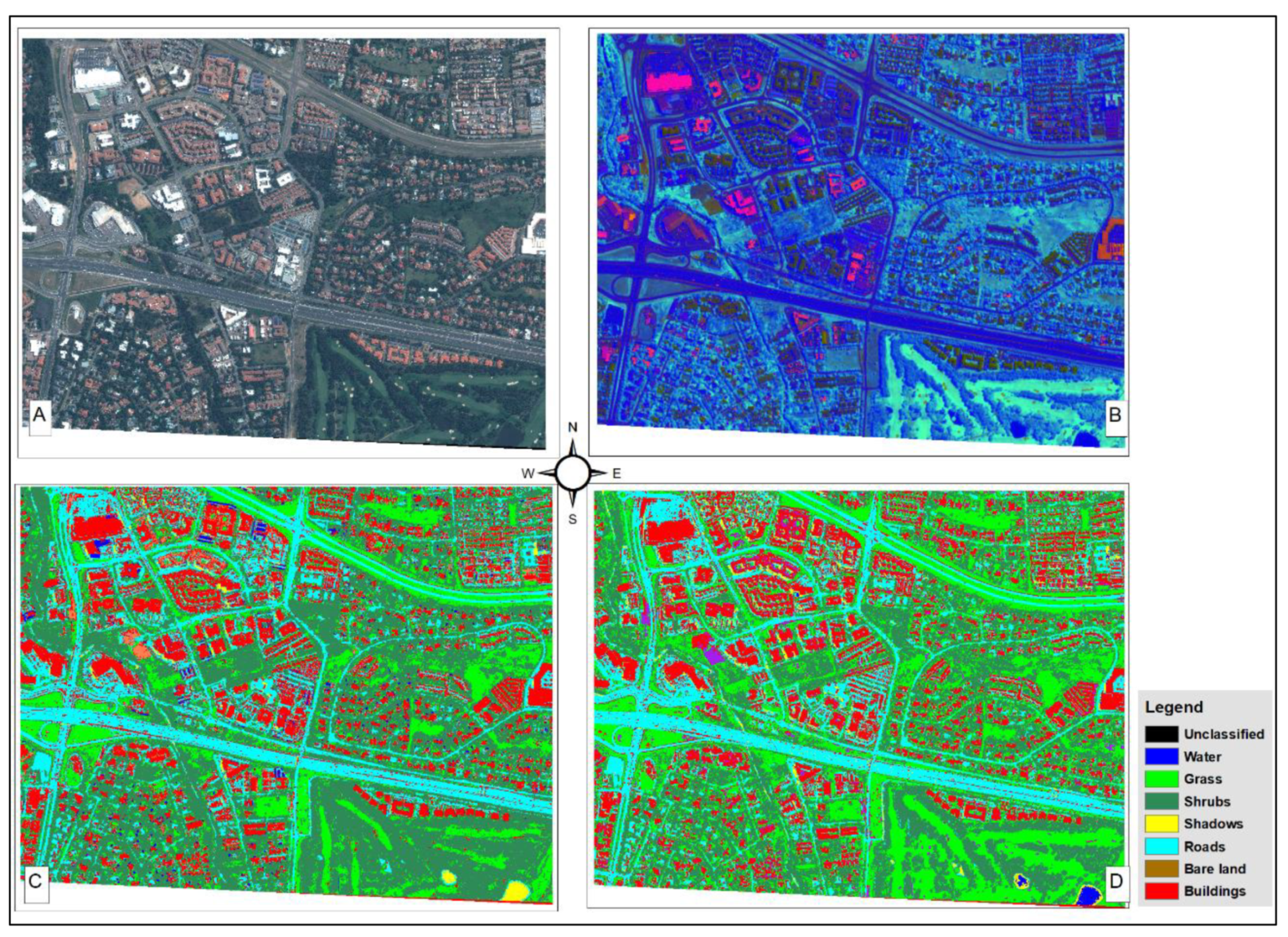1. Introduction
Understanding the often-heterogeneous land cover in urban areas is critical for environmental management, urban spatial planning, and optimal and sustainable use of urban landscapes [
1,
2,
3]. Traditionally, methods used for urban land cover classification involve enumeration, observation, and field surveys. However, these methods are often costly, tedious, time-consuming, and unsuitable for large spatial extents [
4,
5]. The recent advancement in space-borne remote sensing technology provides the capability to quickly acquire high spatial resolution images that provide opportunities for detailed analysis for urban applications such as the often-challenging urban land cover delineation [
6]. Hence, to increase the accuracy of urban landscapes, the recent proliferation of high spatial resolution sensors necessitates a further exploration of various techniques commonly classified into pixel- and object-based approaches.
Pixel-based image classification techniques have been widely adopted for land cover delineation [
7,
8,
9,
10,
11,
12,
13,
14,
15,
16]. Most pixel-based classification methods only utilize the spectral information in the pixels for classification of land cover. Notably, the efficacy of spectrally based pixel-based techniques is limited by landscape heterogeneity typified by urban areas and the ever-increasing suite of high spatial resolution imagery associated with recent sensor advancement. Improved spatial information with ground sampling distance (GSD) less than 2 m, for instance, is inherent in current sensor advancements, such as SPOT 6&7, Pleiades, and IKONOS, and is likely to increase within class spectral variability and interclass spectral confusion, hence lower classification accuracies [
17,
18,
19]. Whereas advanced machine learning algorithms such as support vector machine, artificial neural network, and decision tree have been known to generate significant accuracy in urban land cover mapping [
20], their dependence on statistical information does not allow for exploitation of the rich spatial information that characterize the high spatial resolution sensors. According to Lillesand [
9], their inability to exploit spatial or contextual information related to the pixel impedes optimum performance in a heterogeneous urban landscape [
9]. As an alternative, object-based image analysis (OBIA) techniques were developed to exploit contextual information inherent in heterogeneous landscapes. The increasing popularity of OBIA is attributed to their ability to utilize image spatial characteristics such as tone, shape, pattern, and context. Typically, two distinct methods utilize spatial information from an image: region-based, such as the Grey Level Co-Occurrence Matrix (GLCM), and edge/window-based techniques, such as the Canny edge and Sobel operator. Commonly, edge-based and region-based segmentation are used to partition discrete surface spectral characteristics. Edge-based segmentation, on the other hand, seeks boundaries by distinguishing areas within the image and segments of the complete enclosure by edge pixels [
21]. Consequently, pixels that characterize objects can either form part of the in-segment or constitute a segment as its boundary [
22]. However, the major limitations related to edge-based techniques are insensitivity to noise and are edge-based, hence they are highly dependent on the analysis window which blurs the borders of textured regions [
18,
21].
Morphological image analysis techniques, generally referred to as mathematical morphology (MM) [
23], exploit the spatial domain in images using various techniques based on set theory to estimate and measure many useful geometrical features such as shape, size, and connectivity [
21,
23]. These techniques are developed based on concatenation of mathematical operations grounded in a set of operations such as union, intersection, complementation, and translations [
23]. These operators include erosion, dilation, opening, closing rank filters (including median filters), and top hat transforms [
24]. They are defined in an abstract structure known as an infinite lattice [
24], which is an assumption that an image consists of structures which can be handled by set theory. Morphological image analysis techniques provide useful tools for extracting spatial features from high-resolution remotely sensed images [
2,
3,
4,
5]. These techniques include a family of morphological profiles (MPs) and its advances that include extended morphological profiles (EMPs), derivative of morphological profiles (DMPs), multi-morphological profiles (MMPs), concatenation of morphological profiles (CMPs), attribute profiles (APs), and extended attribute profiles (EAPs) [
4,
5,
6,
7,
8]. These MP techniques process images based on many different types of features such as purely geometric, textural, and contrast-based analysis [
25]. Morphological-based image analysis has the potential to address challenges arising from pixel-based and OBIA by integrating the pixel, region, and object-based image analysis [
26,
27,
28,
29,
30]. Hence, the objective of this study was to test the efficacy of CMP and MMP’s ability to preserve structural information as well as discriminate land cover classes in a heterogeneous urban landscape.
3. Results
A STEP similarity matrix was used to determine the potential of MMP and CMP in discriminating a heterogeneous urban land cover. Specifically, the study sought to discriminate heterogeneous urban land cover types as well as preserving geometrical characteristics of the structures. This was done by comparing thematic and geometric properties of classified objects on a cell-by-cell basis. Each cell was split into quarters to store in a Morton order the four similarity metrics for each classified object which were shape, thematic, edge, and positional similarity of the classified objects. The classification accuracies were obtained by considering the thematic and geometric properties reported in
Table 4,
Table 5,
Table 6 and
Table 7.
The major visual difference interpreted among the thematic maps produced by CMP and MMP algorithms was the amount of thematic misclassified buildings with bare land (
Figure 2A,C,D). Observation, based on field survey and available aerial imagery, revealed that this area is predominantly covered by impervious surfaces, bare land/mining dumps, and eucalyptus trees. Small dams also exist in the area.
Figure 2C shows that CMP misclassified small water bodies with shadows, whereas
Figure 2D shows that MMP discriminated small water bodies from shadows. However, bare lands/mine dumps were often mixed with buildings in both classified maps (
Figure 2C,D). Similar results are shown for an alternative study site (
Figure 3).
The overall weight error matrix classification accuracies obtained for CMP and MMP to evaluate thematic and geometrical characteristics accuracy of objects in the classification of a heterogeneous urban land cover are reported in
Table 4. Thematic and geometrical characteristics were evaluated by considering the shape, thematic, edge, and positional similarity of classified image features. The overall area weight error matrix results were calculated using the STEP similarity matrix. In a STEP similarity matrix, a value of 1 indicates a correctly classified object, while a value of 0 indicates a misclassified object (MCO), hence it suggests a poor shape, thematic, edge or positional similarity of the object.
Table 4 and
Table 5 show the overall thematic and geometric accuracy for CMP and MMP computed on the test set. From the analysis in
Table 4 and
Table 5, it is evident that CMP outperformed MMP in terms of shape, thematic, and edge accuracy for most artificial features. However, for natural features or features without clear boundaries, both CMP and MMP achieved poor shape, edge, and positional accuracy. In terms of shape accuracy, most artificial features, such as buildings/roads and natural features with clear boundaries, such as water, were correctly classified by CMP, achieving high accuracies of 0.86 for buildings, 0.85 for roads, and 0.77 for water, compared to MMP reaching poor shape overall accuracies of 0.22 for buildings, 0.47 for roads, and 0.68 for water. Similar occurrences for edge and thematic accuracy were evident, where artificial features were correctly classified by CMP compared to MMP. However, when evaluating accuracy for the natural features or features without clear boundaries, such as grassland, trees, and shadows, both techniques indicated a poor shape, edge, and positional accuracy. Most low classification accuracy for MMP arise from the geometrical accuracy, which indicates poor preservation of features by MP after its extension to MMP.
The second accuracy assessment was performed for each classification map produced in the study. To evaluate how well both algorithms correctly classified the thematic categories in a heterogeneous urban landscape (i.e., the percentage of correctly classified samples), analysis of the categories was performed to evaluate how well both CMP and MMP utilized statistical information from the dataset to discriminate land cover classes.
Table 6 and
Table 7 show detailed confusion matrices of classification accuracies for CMP and MMP, respectively. The CMP and MMP classification accuracy results over Boksburg and Sunninghill were similar as shown in
Table 6 and
Table 7. Overall, accuracies for CMP were 83.14% and 83.19% for Boksburg and Sunninghill, respectively. Similarly, the MMP overall accuracies were 84.42% and 84.08% for Boksburg and Sunninghill, respectively.
Overall, both CMP and MMP performed almost similarly for artificial objects, such as buildings and roads, in terms of overall classification accuracy. The accuracy assessment shows the overall accuracies of 83% for CMP and 84% for MMP classification. Producer accuracy for water and built-up areas were highest in comparison to other classes in both classifiers, where CMP produced 94% and 90% as compared to 92% and 91% for MMP. Producer accuracy for shadows and grassland was lower for both classifiers, with CMP achieving 40% and 57%, respectively, and MMP achieving 58% and 62%, respectively. However, a relative difference existed among the classifiers when evaluating the individual classes. Individual class type’s producer accuracy indicated fairly high classification accuracy for MMP compared to CMP. A 95% confidence limit revealed a wide variability and overlap in overall accuracy reported between CMP and MMP classification results. Based on this result, the lowest-performing classification model, CMP, was within the range of the best performing MMP.
Based on a comparison among predictions made with optimized feature transformation techniques based on the use of PCA and without the use of PCA, the McNemar test indicated that the difference between CMP and MMP was not statistically significant (p > 0.05).
4. Discussion
This study evaluated the performance of two MM techniques, MMP and CMP, based on a reconstruction approach. The two techniques were evaluated in terms of their ability to distinguish as well as preserve geometrical characteristics of image features in a heterogeneous urban landscape. Morphological profiles based on a reconstruction approach and its extension have been proven in the literature to provide better shape preservation [
24,
25,
31,
32,
33,
34,
35,
36] and classification techniques for land cover classification. The aim of comparing concatenation of morphological profiles by reconstruction transform (CMP) against its extension (MMP) in urban land cover classification was to determine the effects of image dimensionality reduction techniques, such as PCA, to construct MMP geometrical characteristics during urban land cover classification. Specifically, the study sought to evaluate characteristics, such as shape, thematic, edge, and positional similarity, of image objects from very high-resolution data sets.
In general, similar and visually acceptable results were produced for land cover classification using either CMP or MMP image analysis techniques. By visual comparison, both classifiers achieved a fairly significant distinction of heterogeneous urban land cover classes. The MMP provided a better distinction of features, especially separating water bodies from shadows as compared to CMP (
Figure 3). The enhanced classification accuracy is due to the development of MMP which synthesizes spectra-spatial information extracted from multicomponent base images [
25,
33,
36,
37]. The MMP is constructed based on the use of PCA to decrease the curse of the dimensionality problem in standard mathematical profiles which then provide effective separation of the distribution of the classes in the transformed multispectral and panchromatic band. The CMP is challenged in analyzing multispectral bands or statistical information on the imagery, compared to MMP. However, comparing the classifiers in terms of geometrical characteristics preservation and thematic accuracy, CMP outperformed MMP in preserving geometrical characteristics during the classification of features in a heterogeneous urban landscape. This may be because an MMP is constructed from concatenation of EMPs based on PCA. Essentially, PCA is an edge-based image dimensional reduction algorithm which may blur object boundaries. Both CMP and MMP can be used to accurately classify a heterogeneous urban landscape. However, preservation of geometrical characteristics during classification may be challenging, especially for natural boundaries. Objects with natural boundaries may not have crisp edges and are usually affected by boundary blur which results in classification error [
27,
28,
38]. Hence, classifying artificial boundaries, such as buildings, may reach high levels of similarity due to the use of very high-resolution imagery and shapes for natural objects that have crisp edges.
Previous studies evaluated MM techniques based on the comparison of morphological filters using reconstruction transform and standard morphological transformation. Similar results have been observed in related studies [
25,
31,
33,
34,
37] and indicated that morphological profile based on a reconstruction approach had better shape preservation than classical morphological filters. However, extending MPs to MMPs using PCA for dimensionality reduction may decrease the overall capability of MMPs to provide better shape preservation, although it increases its ability to analyze statistical information, which has been a curse for MP.
Overall, the results indicate that the use of MP techniques and its extension based on reconstruction provides better capabilities in classifying a heterogonous urban landscape using very high-resolution imagery. The CMP and MMP techniques address challenges such as speckle or salt and pepper effects from classical remote sensing classification techniques. The results indicate that CMP provides better shape preservation than its extension MMP. However, MMP provides better thematic or class discrimination capability compared to CMP due to the fact of its ability to synthesize spectral–spatial information from current sensor development. The effect of geometrical shape preservation from MMP is due to the use of PCA, which is an edge-based technique that blurs image objects’ shapes.
5. Conclusions
This study evaluated the efficacy of two morphological techniques, one based on the concatenation of MPs (CMP) and the other based on its MMP extension which used PCA to reduce the dimensionality reduction problem associated with MP. The CMP produced an overall accuracy of 83.14% and 83.19% over the two study areas, while MMP produced 84.42% and 84.08% over the two study sites. The study also established that the CMP technique produced better shape accuracy results for artificial land cover features such as buildings/roads and natural features with clear boundaries (e.g., water). This was attested to by high accuracies of 0.86 for buildings, 0.85 for roads, and 0.77 for water. In contrast, MMP produced relatively poor overall classification accuracies in terms of shape. The MMP overall accuracies for shape were 0.22 for buildings, 0.47 for roads, and 0.68 for water. Similar occurrences for edge and thematic accuracy were evident, where artificial features were correctly classified by CMP compared MMP. However, when evaluating accuracy for the natural features or features without clear boundaries, such as grassland, trees, and shadows, both techniques indicated a poor shape, edge, and positional accuracy. Most of the low classification accuracy for MMP arose from the geometrical accuracy which indicates poor preservation of features by MP after its extension to MMP. The study therefore ascertained that that the CMP technique provides an effective tool for analysis of very high spatial resolution remotely sensed images that produce better shape preservation compared to MMP.
The study concludes that CMP and MMP can greatly improve the classification of heterogeneous landscape that typify urban areas by effectively representing the structural landscape information necessary for discriminating related land cover classes. In general, similar and visually acceptable results were produced for land cover classification using either CMP or MMP image analysis techniques. However, concerning the overall classification accuracy, MMP produced slightly higher classification results compared to CMP. Nevertheless, the difference was not statistically significant, with a p-value greater than 0.05. In terms of visual inspection from the thematic maps, MMP could separate features, such as water from shadows, when compared to CMP. Separating water from shadows is commonly a challenge for most remote sensing algorithms. Therefore, MMP can effectively be used for classification of a heterogeneous urban land cover. In summary, it can be concluded that both CMP and MMP techniques are effective in classifying land cover in heterogeneous urban landscape and are particularly effective in discriminating spectrally similar land cover classes.









